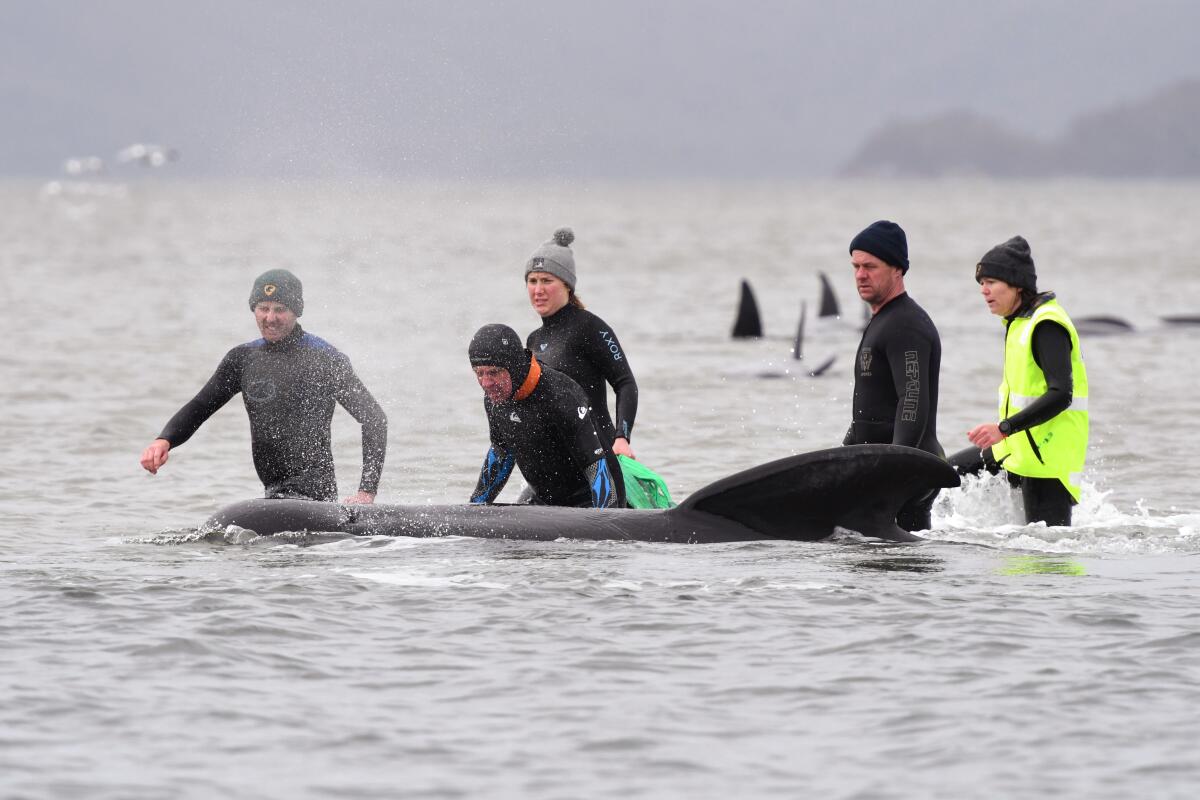Almost 500 pilot whales stranded on Australian island state of Tasmania

- Share via
HOBART, Australia — More pilot whales were found stranded on an Australian coast Wednesday, raising the estimated total to almost 500 — including 380 that have died — in the largest mass stranding ever recorded in the country.
Authorities had already been working to rescue survivors among an estimated 270 whales found Monday on a beach and two sand bars near the remote west coast town of Strahan on the island state of Tasmania.
Another 200 stranded whales were spotted from the air Wednesday less than six miles to the south, Tasmania Parks and Wildlife Service Manager Nic Deka said.
All 200 had been confirmed dead by late afternoon.
They were among 380 whales that had died. Thirty were alive but stranded and 50 have been rescued since Tuesday, Deka said.
“We’ll continue to work to free as many of the animals as we can,” he said. “We’ll continue working for as long as there are live animals.”
About 30 whales in the original stranding were moved from the sandbars to the open ocean, but several got stranded again, Deka said.
About a third of the first group had died by Monday evening, and an update on the death toll and condition of survivors was expected later Wednesday.
Tasmania is the only part of Australia prone to mass strandings, although they occasionally occur on the Australian mainland.
Previously, Australia’s largest such event had occurred in 1996, when 320 pilot whales were stranded near the town of Dunsborough in Western Australia state.
The latest stranding is the first involving more than 50 whales in Tasmania since 2009.
“In Tasmania, this is the biggest [mass stranding] we’ve recorded,” Marine Conservation Program wildlife biologist Kris Carlyon said.
Rescue crews remained optimistic about freeing more whales, Carlyon said.
With cool weather helping, “we’ve got a very good chance of getting more off that sandbar,” he added.
Why the whales ran aground is a mystery. The pod may have been drawn into the coast to feed or by the misadventure of one or two whales, which led the rest of the pod to follow, Carlyon said.
“It’s really likely this was the one stranding event of a big group. This would have been one big group offshore,” Carlyon said.
Marine scientist Vanessa Pirotta said there are a number of reasons whales might become beached, including navigational errors.
“They do have a very strong social system; these animals are closely bonded, and that’s why we have seen so many in this case, unfortunately,” Pirotta told the Australian Broadcasting Corp.
And rescuing them doesn’t always work, “because they are wanting to return back to the pod, they might hear the acoustics for the vocalizations of the sounds that the others are making, or they’re just disoriented and, in this case, extremely stressed and just probably so fatigued that they in some cases don’t know where they are,” she added.
In neighboring New Zealand, more than 600 pilot whales washed up on the South Island at Farewell Spit in 2017.
More to Read
Sign up for Essential California
The most important California stories and recommendations in your inbox every morning.
You may occasionally receive promotional content from the Los Angeles Times.













